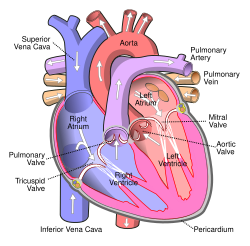Pulmonary trunk
| Pulmonary artery | |
|---|---|
| Details | |
| Precursor | truncus arteriosus |
| System | Cardiovascular, Respiratory |
| Source | right ventricle |
| Identifiers | |
| Latin | truncus pulmonalis, arteria pulmonalis |
| MeSH | A07.231.114.715 |
| Dorlands /Elsevier |
t_20/12826098 |
| TA | A12.2.01.001 |
| FMA | 8612 |
|
Anatomical terminology []
|
|
The pulmonary artery carries deoxygenated blood from the heart to the lungs.
In the human heart, the pulmonary trunk (pulmonary artery or main pulmonary artery) begins at the base of the right ventricle. It is short and wide—approximately 5 centimetres (2.0 in) in length and 3 centimetres (1.2 in) in diameter. It then branches into two pulmonary arteries (left and right), which deliver deoxygenated blood to the corresponding lung.
The pulmonary arteries originate from the truncus arteriosus and the sixth pharyngeal arch. The truncus arteriosis is a structure that forms during the development of the heart as a successor to the conus arteriosus.
By the third week of embryological life, the endocardial tubes have developed a swelling in the part closest to the heart. The swelling is known as the bulbus cordis and the upper part of this swelling develops into the truncus arteriosus The structure is ultimately mesodermal in origin. During development of the heart, the heart tissues undergo folding, and the truncus arteriosus is exposed to what will eventually be both the left and right ventricles. As a septum develops between the two ventricles of the heart, two bulges form on either side of the truncus arteriosus. These progressively enlarge until the trunk splits into the aorta and pulmonary arteries.
During embryological life, the ductus arteriosis connects the pulmonary trunk and the arch of aorta, allowing blood to bypass the lungs.
The pulmonary artery carries deoxygenated blood from the right ventricle to the lungs. The blood here passes through capillaries adjacent to alveoli and becomes oxygenated as part of the process of respiration.
...
Wikipedia


